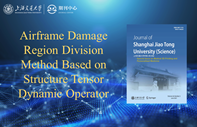In order to improve the accuracy of damage region division and eliminate the interference of damage adjacent region, the airframe damage region division method based on the structure tensor dynamic operator is proposed in this paper. The structure tensor feature space is established to represent the local features of damage images. It makes different damage images have the same feature distribution, and transform varied damage region division into consistent process of feature space division. On this basis, the structure tensor dynamic operator generation method is designed. It integrates with bacteria foraging optimization algorithm improved by defining double fitness function and chemotaxis rules, in order to calculate the parameters of dynamic operator generation method and realize the structure tensor feature space division. And then the airframe damage region division is realized. The experimental results on different airframe structure damage images show that compared with traditional threshold division method, the proposed method can improve the division quality. The interference of damage adjacent region is eliminated. The information loss caused by over-segmentation is avoided. And it is efficient in operation, and consistent in process. It also has the applicability to different types of structural
damage.

CAI Shuyu∗ (蔡舒妤), SHI Lizhong (师利中)
. Airframe Damage Region Division Method Based on Structure Tensor Dynamic Operator[J]. Journal of Shanghai Jiaotong University(Science), 2022
, 27(6)
: 757
-767
.
DOI: 10.1007/s12204-022-2498-2
[1] SHI L Z. Airframe damage region dynamic division based on structural tensor characteristics [J]. Acta Aeronautica et Astronautica Sinica, 2018, 39(11): 184-194 (in Chinese).
[2] OSMAN M Z, MAAROF M A, ROHANI M F. Improved dynamic threshold method for skin colour detection using multi-colour space [J]. American Journal of Applied Sciences, 2016, 13(2): 135-144.
[3] GOU D D, WEI Y, FU H, et al. Retinal vessel extraction using dynamic multi-scale matched fifiltering and dynamic threshold processing based on histogram fitting [J]. Machine Vision and Applications, 2018, 29(4): 655-666.
[4] ZHANG F F, LI J S, ZHANG B, et al. A simple automated dynamic threshold extraction method for the classification of large water bodies from landsat-8 OLI water index images [J]. International Journal of Remote Sensing, 2018, 39(11): 3429-3451.
[5] ZHANG J S, WANG M Q, GUO J Q, et al. Dynamic threshold segmentation of bubble defects in BGA solder balls [J]. Fire Control & Command Control, 2018, 43(10): 113-116 (in Chinese).
[6] NAKAMURA S, SAITOH F. Image binarization by dynamic convex quadrilateral region segmentation using GA [J]. Electronics and Communications in Japan, 2016, 99(1): 53-61.
[7] CHEN D, COHEN L D. Vessel tree segmentation via front propagation and dynamic anisotropic Riemannian metric [C]//2016 IEEE 13th International Symposium on Biomedical Imaging. Prague: IEEE, 2016: 1131-1134.
[8] KATULEV A N, KHRAMICHEV A A. Automatic wavelet-based segmentation of a background-and�target frame from an optoelectronic device for detection of dynamic objects in 2D images [J]. Journal of Optical Technology, 2016, 83(2): 98.
[9] KUSHWAHA A K S, SRIVASTAVA R. A framework for moving object segmentation using dynamic back�ground modelling and shadow suppression in complex wavelet domain [J]. The Imaging Science Journal, 2016, 64(5): 267-278.
[10] TAN X, LIU Y, XIAO H X, et al. A real-time cascaded video denoising algorithm using intensity and structure tensor [J]. IEICE Transactions on Information and Systems, 2015, 98(7): 1333-1342.
[11] MEWADA H, PATEL R, PATNAIK S. A novel structure tensor modulated Chan-Vese model for texture image segmentation [J]. The Computer Journal, 2015, 58(9): 2044-2060.
[12] HASSAN T, AKRAM M U, SHAUKAT A, et al. Structure tensor graph searches based fully automated grading and 3D profiling of maculopathy from retinal OCT images [J]. IEEE Access, 2018, 6: 44644-44658.
[13] GE H L, SUN Y H, HUANG Y M, et al. SAR image segmentation with structure tensor based hierarchical student’s t-mixture model [J]. Journal of Internet Technology, 2020, 21: 615-628.
[14] LI Y S, LI Z Z, DING Z Q, et al. Automatic infrared ship target segmentation based on structure tensor and maximum histogram entropy [J]. IEEE Access, 2020, 8: 44798-44820.
[15] CAI S Y, SHI L Z. Airframe damage image transition region extraction method based on improved spectral clustering [J]. Journal of Computer-Aided Design & Computer Graphics, 2016, 28(10): 1732-1739 (in Chinese).



